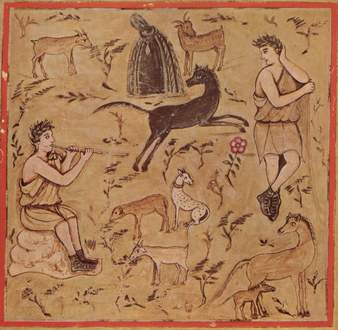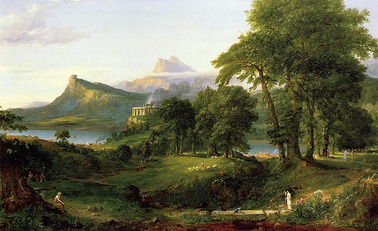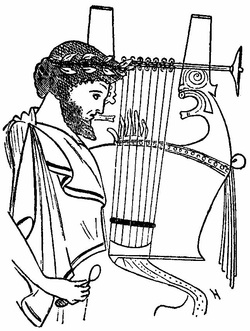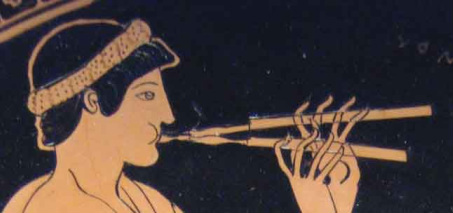Greek Music and the Pastoral Mode
Introduction

Although I am conducting my research on the music of China, Greek pastoral poetry and the Greek musical tradition are a very important part of my studies. The main poets and music that I have studied and applied to my research come from ancient Greece between the 1st and 6th century BCE. Each poet I studied offers a different perspective on the idea of pastoral poetry as well as the role musical accompaniment plays in their recitation. The Idylls and poems written at that time were some of the first poems ever written in the pastoral style. The following articles each focus on a different aspect of the ancient Greek tradition that apply to my research.
Pastoral Poetry

Pastoral poetry focuses on portraying the lifestyle of a shepherd or herder in a very idealized manor. The shepherd is viewed in a very romanticized light while still conveying the idea that this style of living was not only simpler, but closer to the lifestyle experienced during the golden age. Ancient Greek pastoral poems often revolved around mythical creatures or gods and their interaction with the mortal world. One of the most important aspects of this poetry is its connection to nature. These idylls (short pastoral poems) would often have the shepherd reciting poetry that connected the actions of both gods and man directly to nature. One such example can be found in an excerpt from Lament for Adonis by Bion (100 BCE).
Ah, ah, Cytheria! Adonis is dead.
She wept tear after tear with the blood which was shed,
And both turned into flowers for earth's garden-close,
Her tear to the wind-flower; his blood to the rose.
Ah, ah, Cytheria! Adonis is dead.
She wept tear after tear with the blood which was shed,
And both turned into flowers for earth's garden-close,
Her tear to the wind-flower; his blood to the rose.
In this excerpt, the shepherd is referencing Aphrodite mourning the loss of her lover Adonis. Adonis was killed by a boar during a hunt he embarked on as a rite of passage. Her sadness is portrayed to be so powerful that nature itself not only felt her pain, but also could also react to it. This idea of connecting the emotions and interactions of people or gods with the working of nature creates a very powerful image. On a similar note, the idea of the pathetic fallacy is important to this genre of writing. This is the idea of viewing inanimate objects as having the ability to feel emotions much like humans do. This is very clearly represented in pastoral poetry in the form of having nature show empathy or other emotions as a reaction to human doings.
Another important aspect of pastoral poetry is its unique relationship to music. The instrument most commonly associated with shepherds and pastoral writing at this time was the pan flute. A simple instrument, it usually consisted of at least five pipes of varying length tied together. It sounds similar to the flute but with a much more limited range. It was named and most closely associated with Pan, the god of the wild and companion to the shepherd. While closely associated with pastoral poetry, the idylls were very rarely accompanied by the pan flute or any other instrument. The idyll would have a rhythmic meter to it and reference the presence of some sort of musical instrument, but when recited, it is believed that the performer recited the poem unaccompanied. There are exceptions to this, such as the musician and poet Orpheus. Considered to be the most legendary and talented musician in Greek history, it was said that Orpheus could charm all living things with his music. It was even fabled that he could move rocks with his playing. He often would sing his poetry with the help of a cithara (lyre).
Another important aspect of pastoral poetry is its unique relationship to music. The instrument most commonly associated with shepherds and pastoral writing at this time was the pan flute. A simple instrument, it usually consisted of at least five pipes of varying length tied together. It sounds similar to the flute but with a much more limited range. It was named and most closely associated with Pan, the god of the wild and companion to the shepherd. While closely associated with pastoral poetry, the idylls were very rarely accompanied by the pan flute or any other instrument. The idyll would have a rhythmic meter to it and reference the presence of some sort of musical instrument, but when recited, it is believed that the performer recited the poem unaccompanied. There are exceptions to this, such as the musician and poet Orpheus. Considered to be the most legendary and talented musician in Greek history, it was said that Orpheus could charm all living things with his music. It was even fabled that he could move rocks with his playing. He often would sing his poetry with the help of a cithara (lyre).
Lyre and Cithara

The lyre is considered to be one of the most important instruments in the ancient Greek musical tradition. It is a stringed instrument that is constructed similarly to a harp but is strummed like a guitar or zither rather than plucked like a traditional harp. The body of the instrument was often constructed of a turtle shell with two wooden bars extending from either side. The strings would be stretched over the shell and the wood in order to create the guitar like tones. In Greek mythology, the lyre was originally created by the god Hermes. He slaughtered a cow from the god Apollo's sacred herd to create the gut strings. When Apollo found out that Hermes had slaughtered his cow, he was furious. However, Hermes escaped punishment by offering the lyre to Apollo as a gift.
The lyre exists in many different forms all around the world in different cultures and eras. In ancient Greek culture, the lyre was most often represented by an instrument called a cithara. Pictured left, the cithara was considered a more professional form of the lyre. It had more strings than the lyre and was used by very skilled musicians and poets during recitations. The instrument also had a close association with the Apollonian ideas of moderation and equilibrium.
The lyre exists in many different forms all around the world in different cultures and eras. In ancient Greek culture, the lyre was most often represented by an instrument called a cithara. Pictured left, the cithara was considered a more professional form of the lyre. It had more strings than the lyre and was used by very skilled musicians and poets during recitations. The instrument also had a close association with the Apollonian ideas of moderation and equilibrium.
Aulos

The aulos is the other main important instrument associated with ancient Greek culture. Consisting of two flute like pipes, the aulos is actually more closely related to the modern day oboe than a flute. This is because the aulos was generally created utilizing a double reed instead of air rushing over an opening like a flute. This instrument was played to accompany a variety of events and occasions, the most popular being for athletic events and dramas. The instrument was also believed to be used for marriage ceremonies. The instrument is described to be quite shrill and piercing. One of the pipes was used to create a drone tone (similar to that of a bagpipe) while the other was used to create the melodic content. The mythological origin of this instrument is an important lesson in hubris (overwhelming pride) in ancient Greek culture. Marsyas, a saytr, is credited as the inventor of the instrument. However, there is other information that tells of Athena being the creator but discarding the instrument because it made her cheeks puff out as she played it, marring her beauty. Either way, Marsyas decided that he would challenge Apollo to a musical contest. The prize was being able to do whatever the winner wanted to the loser. Like the nature of many saytrs, Marsyas desired a prize sexual in nature. However, Apollo and his lyre defeated Marsyas in the contest. Apollo felt that the punishment for Marsyas' hubris would be stringing him up to a tree and flaying him. It is said that the blood an tears shed by Marsyas that day created the Marsyas river in Asia Minor. This story is one of many that created the association of the aulos with arrogance and ecstasy. The lyre and the aulos often represented a kind of duality that was meant to be a form of balance.
The following clips are examples of what the aulos and lyre sound like. They also serve as a representation of music that would have been performed in ancient Greece
Aulos
Source
Cithara
Michael Levy
Source
Bibliography
McKenna, Rosemary, and Kenneth J. . Atchity. The Classical Greek Reader. Oxford: Oxford UP, 1996. Print.
Patterson, Annabel M. Pastoral and Ideology: Virgil to Valéry. Berkeley: University of California, 1987. Print.
Sachs, Curt. The Rise of Music in the Ancient World, East and West. New York: W.W. Norton &, 1943. Print.
West, Martin L. Ancient Greek Music. Oxford: Clarendon, 1994. Print.
Theocritus, and Charles Stuart Calverley. Theocritus [Idylls]. Freeport, NY: for Libraries, 1972. Print.
Virgil, and David Ferry. The Eclogues of Virgil: a Translation. New York: Farrar, Straus, and Giroux, 2000. Print.
Patterson, Annabel M. Pastoral and Ideology: Virgil to Valéry. Berkeley: University of California, 1987. Print.
Sachs, Curt. The Rise of Music in the Ancient World, East and West. New York: W.W. Norton &, 1943. Print.
West, Martin L. Ancient Greek Music. Oxford: Clarendon, 1994. Print.
Theocritus, and Charles Stuart Calverley. Theocritus [Idylls]. Freeport, NY: for Libraries, 1972. Print.
Virgil, and David Ferry. The Eclogues of Virgil: a Translation. New York: Farrar, Straus, and Giroux, 2000. Print.